From excavating an abandoned town to fighting viral infections to restoring a prairie, Wright State University faculty and students are undertaking numerous and important research endeavors. Here are some of the Newsroom’s top research stories of 2018.
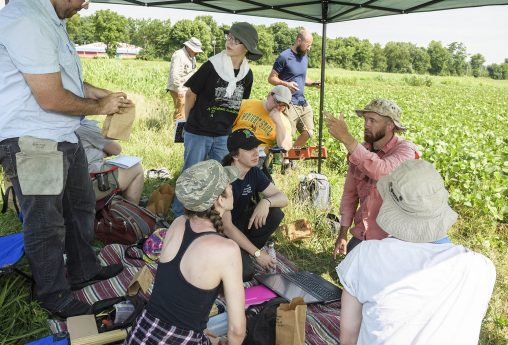
Students in the Field School in Archaeology excavated a field to learn more about life in Old Osborn, near Wright-Patterson Air Force Base.
Nearly a century ago, it was a bustling hamlet with a railroad station, businesses, grain silos and rows of houses lined up like soldiers along the rail line. Today, it’s a soybean field with no visible evidence of its history to passing motorists.
But Wright State University students in the College of Liberal Arts Field School in Archaeology have collected evidence of the original Osborn, a town that was relocated to protect it from flooding following the Great Dayton Flood of 1913.
“Osborn is important for a lot of reasons, mainly for regional history in connection with this natural disaster that happened in 1913,” said Lance Greene, assistant professor of anthropology. “It’s also important in the development of flood control in the United States as a whole.”
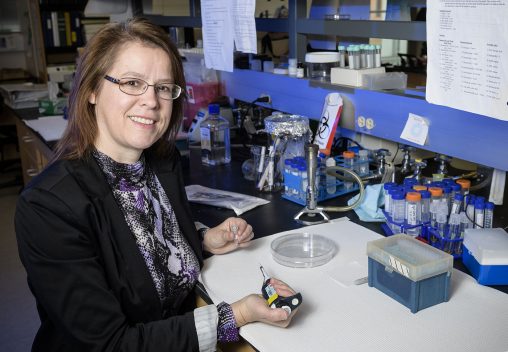
Kate Excoffon, professor of biology, received $1.8 million in funding from the National Institute of Allergy and Infectious Diseases to research an anti-viral therapy.
Wright State biologists investigating approach to combat viral respiratory infections
A team of Wright State University biology researchers is making strides on a novel approach to combatting viral respiratory infections. The work is funded by an award from the National Institute of Allergy and Infectious Diseases, part of the National Institutes of Health. The project is expected to receive approximately $1.8 million over five years.
Led by Kate Excoffon, professor of biology, the team has investigated viral receptors, which must be present on human cells in order for the virus to attach to them and cause infection. The more viral receptors, the more potential for infection.
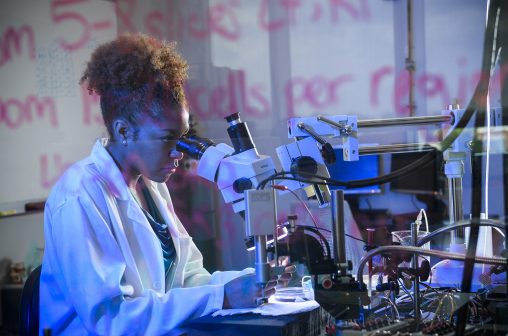
Christiana Draper, an M.D./Ph.D. student, won a National Institutes of Health Diversity Supplement Award to support her research.
She has driven a Navy destroyer, flown a fighter jet, piloted a helicopter and even helped guide a ballistic missile submarine.
Christiana Draper also played Division III college basketball for Spelman College in Atlanta, graduated with the highest academic distinction of summa cum laude, is now a student at the Wright State University Boonshoft School of Medicine and quietly aspires to be U.S. surgeon general.
Draper received a National Institutes of Health Diversity Supplement Award, which brings scholarship money and support for her research in a lab directed by Sherif Elbasiouny, a neuroengineer who is working to develop new treatment options for Amyotrophic Lateral Sclerosis (ALS).
“I really want to do a postdoc/residency at Walter Reed Military Center,” said Draper. “I’m really interested in neuro-rehabilitation, spinal cord injury, limb loss.”
Cancer research project includes contributions from undergrad students
A team of Wright State University chemistry researchers is working on a novel approach to fighting cancer thanks to a three-year, $462,195 award from the National Institutes of Health.
Kuppuswamy Arumugam, an assistant chemistry professor in the Wright State College of Science and Mathematics, and Jonathan F. Arambula from The University of Texas at Austin, are leading the effort, which includes postdoctoral, graduate and undergraduate researchers.
The R15 award from NIH is designed in part to help expose undergraduates to research. It aims to involve students in research a way that is intellectually stimulating, experience-driven and significant to the research. Students will be involved in participation in the design of experiments, collection and analysis of data, presentations at meetings and drafting journal articles.
The research project by Arumugam’s team is aimed at developing more effective cancer therapeutics using a combination of synthetic chemistry and biological high throughput screening. Arumugam, who teaches organic chemistry, said his team is making new chemical compounds with the goal of using them as anti-cancer drugs.
Restored prairie at Wright State serves as wildlife magnet, research lab and scenic wonder
It may be the most beautiful spot on the Wright State University campus, but few people even know it’s there. It’s nearly two acres of restored prairie — a kaleidoscope of colorful wildflowers and dancing butterflies. A chorus of birds and insects. A dazzling display of nature.
Three years in the making, the prairie is the work of the Department of Biological Sciences. Students and faculty members hand-tossed a strategic mix of seeds designed to create a palette of plants that would blossom at different times throughout the season as well as attract and nourish birds and insects. The prairie has become a colorful carpet underneath a line of power transmission towers that straddles the campus.
A $454,967 federal research award will help associate biology professor Andrew Voss and his Wright State University students investigate Huntington’s disease.
Huntington’s disease, which has no cure, deteriorates a person’s physical and mental abilities during their prime working years. Today, there are about 30,000 symptomatic Americans and more than 200,000 at risk of inheriting the disease.
The three-year research award from the National Institutes of Health/National Institute of Neurological Disorders and Stroke is aimed at determining if there is a primary disease of the muscle in Huntington’s disease.
“We did find defects in the muscle of Huntington’s disease mice,” said Voss. “But the question is how much of that is due to a nerve degeneration versus how much of it is muscle itself? And do the muscle defects also feedback to the nervous system?”
Wright State research engineer Matthew Sherwood studies effects of fatigue, reduced oxygen
Wright State University research engineer Matthew Sherwood has received $501,000 from the U.S. Navy to study the physiological reaction to fatigue and reduced oxygen. The Cerebral Hemodynamic Studies of Hypoxia and Fatigue is a combined effort between Sherwood’s research team and the Naval Medical Research Unit Dayton.
The $501,000 award from the Naval Medical Logistics Command includes $308,000 for the two-year fatigue study and $193,000 for the one-year hypoxia study. For the past few years, Sherwood has researched an initiative that trains people to control their brain activity while undergoing functional magnetic resonance imaging, or brain scans.
“We target a specific region of the brain, pull out the signals in real time, display those to the person and have them try to alter those signals,” he said.
Computer science and engineering researchers developing a pilotless drone
Helping develop a pilotless “Air Uber” drone that could ferry medical supplies or emergency responders to disaster zones is the goal of a Wright State computer science and engineering team.
The researchers are part of an industry and university group that received $2 million from the Ohio Federal Research Network grant in support of unmanned aerial vehicle research and development. The Wright State researchers, led by Yong Pei, associate professor of computer science and engineering, were awarded $150,000 for their part of the project.
The aircraft could be useful in disaster relief as well as surveillance since the drone would be able to stay aloft for longer periods of time since there would be no human pilot. Pei said the drones could be used to deliver medical supplies to areas that pose a risk to aircraft and human pilots.
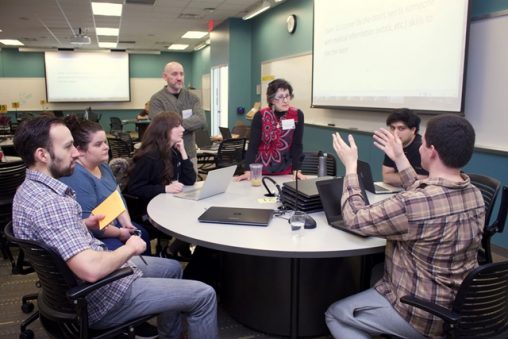
nnovation Weekend brought students from four colleges together to devise potential solutions to real-world problems in the handling of battlefield injuries and mass-casualty situations.
An intensive, three-day brainstorming exercise at Wright State University boosted the confidence of students, who came up with potential solutions to real-world problems in the handling of battlefield injuries and mass-casualty situations.
The first-ever Innovation Weekend — hosted by the College of Science and Mathematics — attracted about 35 students from four different colleges to the Student Success Center in April.
The challenge posed to the students was how to improve the medical monitoring and documentation of patients from the point of injury through all of the transport points until arrival at the final hospital destination. After nearly 48 hours of work, six teams of students presented solutions to an outside panel of experts.
Innovation Weekend was designed based on a “hackathon” approach to problem-solving that is becoming increasingly common in the private sector. The goal was to encourage and enhance an entrepreneurial and innovative mindset in undergraduate students across diverse majors. It was also designed to foster closer ties with the private sector and expose students to experiences of regional workforce relevance.
Augmented-reality system wins Ohio Opioid Technology Challenge
An augmented-reality system designed by Wright State researchers that puts a “doctor in the house” to help recovering surgery patients manage pain without painkillers was a winner in the Ohio Opioid Technology Challenge.
The technology was developed by Yong Pei, associate professor of computer science and engineering, and David Martineau, medical director of the Hand and Orthopedic Center of Excellence in Kettering Health Networks, along with a group of graduate researchers.
The project, in partnership with Kinematechs LLC of Cincinnati, began four years ago as part of investigating the use of artificial intelligence, augmented reality and motion analysis in applied medical research and using technology to effectively deliver health care to patients.
Want more news?
More research news from Wright State is available at wright.edu/university-research.

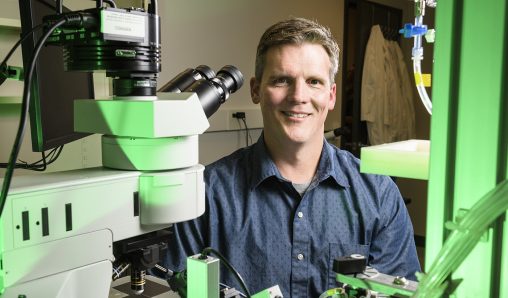
 Wright State business professor, alumnus honored by regional technology organizations
Wright State business professor, alumnus honored by regional technology organizations  Wright State University Foundation awards 11 Students First Fund projects
Wright State University Foundation awards 11 Students First Fund projects  Gov. DeWine reappoints Board Treasurer Beth Ferris and names student Ella Vaught to Wright State Board of Trustees
Gov. DeWine reappoints Board Treasurer Beth Ferris and names student Ella Vaught to Wright State Board of Trustees  Joe Gruenberg’s 40-Year support for Wright State celebrated with Honorary Alumnus Award
Joe Gruenberg’s 40-Year support for Wright State celebrated with Honorary Alumnus Award  Wright State’s elementary education program earns A+ rating for math teacher training
Wright State’s elementary education program earns A+ rating for math teacher training 